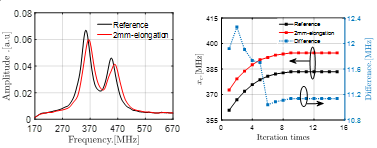In last decade, the distributed fiber sensors are attracting wide attentions for practical applications, such as Brillouin optical time domain reflectometer (BOTDR), which has been widely used in health monitoring of civil structure, safeguarding of pipeline and railway. However, the accuracy of Brillouin Frequency Shift (BFS) extraction suffers from the weakness of Brillouin scattering, and the traditional BFS extraction method is time consuming. These pose great limitations for BOTDR applications.
Recently, researchers at Shanghai Institute of Optics and Fine Mechanics, Chinese Academy of Sciences, theoretically and experimentally demonstrate two iterative method, iterative centroid analysis (ICA) and iterative quadratic fitting (IQF), to extract BFS from noise signals of BOTDR with fast processing speed.
Their analyses show that the accuracy of extracted BFS is deduced as a function of signal-to-noise ratio (SNR), frequency step, Brillouin linewidth, and the data window used in the BFS extraction.
Theoretically, it is found that the BFS variances are largely affected by the data window deviation (DWD). Thus, an iterative method was proposed to reduce the DWD caused error. In the first step, they took the frequency at maximum of spectrum obtained by averaging of several traces as the data window center xm. The trace number M in averaging could be adjusted according to the signal noise level. Following this, they carried out centroid analysis (quadratic fitting) for the M averaged spectrum with xm as data window center. A new peak frequency xc was then obtained. To the end, xm was replaced by xc and the second step was repeated until the extracted peak converges to a stationary value. The whole process can be displayed in the Figure 1.

Fig. 1 (a) The extracted centroids, (b) The extracted BFS by IQF and (c) its standard deviation.
The comparison with Lorentzian fitting (LF) shows that the accuracy of iterative methods are the same level as by the iterative operation. Since the processing time of centroid analysis and quadratic fitting are extremely short, the speed of iterative methods are still much faster than that of LF. One important advantage of ICA is its feasibility for extracting BFS from complicated spectra, which has large impact on the BSF accuracy. The feasibility of ICA can be verified by field project, which are shown in the Figure 2.

Fig. 2 (a) the spectra of slope health monitoring project; (b) the results of ICA for spectra of the project.
In summary, the proposed methods have great meaning for practical engineering applications and dynamic measurement. The advantages of ICA are noticeable, especially for complicated spectrum. It is believed that, besides BOTDR, the iterative methods may be used in other data processing, such as BOTDA, Raman spectroscopy, etc.
These researches, entitled "Detailed Evaluation of Centroid Analysis for Extracting Brillouin Frequency Shift of Fiber Distributed Sensors" and "Brillouin Frequency Shift of Fiber Distributed Sensors Extracted from Noisy Signals by Quadratic Fitting" have been published in IEEE Sensors Journal and MDPI Sensors respectively.
This work was supported in part by the National Natural Science Foundation of China (NSFC): 61377062, 61475165, 61405227, and 61675216; and in part by the Science and Technology Commission of Shanghai Municipality (STCSM): 15XD1524500, 18DZ1201303.
Article website:
https://ieeexplore.ieee.org/abstract/document/8491390
https://www.mdpi.com/journal/sensors
Contact:
Mr. Cao Yong
General Administrative Office
Shanghai Institute of Optics and Fine Mechanics, CAS
Email: caoyong@siom.ac.cn